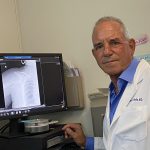Community physicians are doing their best to ride out the COVID-19 pandemic and keep their businesses viable while also keeping their staff and patients safe. The continuing need for enhanced safety precautions and lasting declines in patient volumes have taken a toll, both in terms of revenue losses and increasing workloads. The only option is to keep moving forward in hopes that things will get back to normal soon, says Norman Gaylis, MD, a community rheumatologist in Aventura, Fla.
Following up on his July interview related to the financial effects of the pandemic, Dr. Gaylis spoke to The Rheumatologist (TR) again about how his practice is faring as the pandemic drags on.
TR: Over the summer, you were concerned about keeping your practice financially viable. What do things look like for you now?
Dr. Gaylis: Since then, we’ve definitely come back to a more normal patient flow. But it’s still probably off about 20–25% because patients are very apprehensive about coming into the office.
We’re still trying to protect all patients and staff by being proactive with body temperature measurements, social distancing and rapid testing to reduce the risk of COVID exposure and have seemingly managed to do so to this point. We presented an abstract at ACR Convergence 2020 to show our results.
Financially, I’m wondering if we’ll ever get any more help from the Paycheck Protection Program. This pandemic has taken a significant economic hold on businesses, as well as families, so having further support for the practice is critical.
But the reality is, we can’t make up what we lost. I’m projecting that our revenues are going to be down somewhere in the region of 30–35% by the end of the year.
TR: In July, you began implementing furlough days for staff. How did it go?
Dr. Gaylis: Dealing with the staffing was—quite honestly—very difficult. I basically asked everybody to take off one day a week and [accept] a 20% reduction in salary. But after one month, I realized it wasn’t going to work. Everybody in this practice is a link in the chain; so when we took a link out, it became less productive and more costly.
The staff is working now pretty much for the same salaries they were prior to the pandemic. The people who have taken the brunt of the financial burden are the physicians, the providers. My thinking was the highest salary people should take a reduction in salary, because we can probably deal with it, as much as it’s not very pleasant.
TR: How have you and your patients adapted to using telemedicine?
Dr. Gaylis: Telemedicine was very helpful for maintaining a conversation with our patients and trying to help them when they couldn’t get into the office. It’s still a challenge for some of our older patients to use, and I’d much rather do a face-to-face visit because there is a certain chemistry between you and your patient that doesn’t come through on telemedicine.
TR: Are you planning to continue telemedicine services post-COVID-19?
Dr. Gaylis: As long as there’s a demand and the insurance companies keep on reimbursing, we’ll definitely do it. It’s extremely important for those people who don’t have transportation, who physically don’t have the capacity to come to us, who are nervous or apprehensive and who they themselves may be symptomatic.
From a rheumatology perspective, being able to give people injections or infusions or do any kind of studies, such as X-rays—we obviously can’t do that with telemedicine. But it works to a certain point.
TR: How has the pandemic affected other aspects of your practice?
Dr. Gaylis: We haven’t opened up our physical therapy and rehab department because there’s still a very limited population of patients who want to come in and have a therapist work with them in close proximity. Besides that, we’ve pretty much gotten back into doing all the various services we offer, including infusions, bone density screenings and X-rays.
The clinical research was probably the area in our office that got hurt the most. Clinical research was very dependent on the pharmaceutical industry, which sponsors the studies. And they pretty much shut down the research studies during the pandemic. Having spoken to my rheumatology colleagues, the reduction in research business has been huge for all of us. We’ve got to get that back up and running because it’s important for pharma and ourselves—and also for our patients so we can get the right treatments for them that they otherwise wouldn’t have access to.
TR: How are you advising patients on COVID-19 vaccination, and are you using ACR resources to help?
Dr. Gaylis: We’re using the guideline for our standard vaccines, whether it’s influenza, shingles or others.
I’m not touching on the COVID-19 vaccine at this point, because there’s nothing to talk about. We don’t have a vaccine. So at this point, I’m going to say to [patients], let’s just wait and see.
Kimberly J. Retzlaff is a freelance medical journalist based in Denver.




